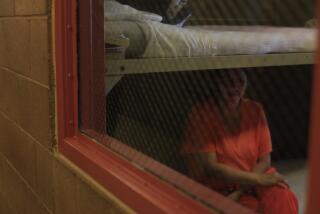Prison protests begin with list of demands
Inmate leaders at Californiaâs supermax prison near Oregon on Monday launched what they said is a statewide protest of policies that hold prisoners in isolation indefinitely, a continuance of the same grievances behind statewide hunger strikes two years ago.
âCalifornia officials have refused to meaningfully negotiate with us over our reasonable demands,â the four inmates said in a statement provided to The Times on Monday by their lawyers. The document includes a list of eight âdemands,â starting with a five-year limit on the time prisoners can be held in isolation in Segregated Housing Units, and a 90-day limit on the time inmates can be kept in the more temporary Administrative Segregation cells.
There are 4,527 inmates being held in âsegregationâ cells at four state prisons, including 1,180 at Pelican Bay State Prison, where the protest leaders are based. Inmates can be held indefinitely in the isolation units and are required to spend almost all of their time within the Spartan cells, with reduced privileges, access to outside food, visits or rehabilitation programs.
For months, the Pelican Bay inmate leaders have called for a hunger strike and work stoppage to begin Monday. Corrections officials by midday released no information on the number of inmates refusing meals or refusing to report to their work assignments within the state prison system. The state, by policy, wonât recognize a mass protest until participants have missed at least nine consecutive meals.
A week ahead of the planned statewide protest, 13 inmates on Monday began their eighth day without meals at the High Desert State Prison. They are protesting conditions in their own administrative segregation unit. According to their own list of demands, obtained by The Times, they seek more and better food, cleaner clothing and bedding, hats and gloves in the winter, law library materials and weekly rounds by prison officials to address inmate complaints.
The Pelican Bay list of demands also includes increased visitation with family, education and rehabilitation programs, and a streamlined six-month process for inmates to earn return to the general prison population. The state recently started a âstep-downâ program that takes as long as five years for Segregated Housing Unit inmates to return to the main prison population.
ALSO:
Prison hunger strikes begin at High Desert
Federal judges refuse to delay prison release order
Federal judges order California to free 9,600 inmates
Follow updates at @paigestjohn
More to Read
Get the L.A. Times Politics newsletter
Deeply reported insights into legislation, politics and policy from Sacramento, Washington and beyond. In your inbox three times per week.
You may occasionally receive promotional content from the Los Angeles Times.











